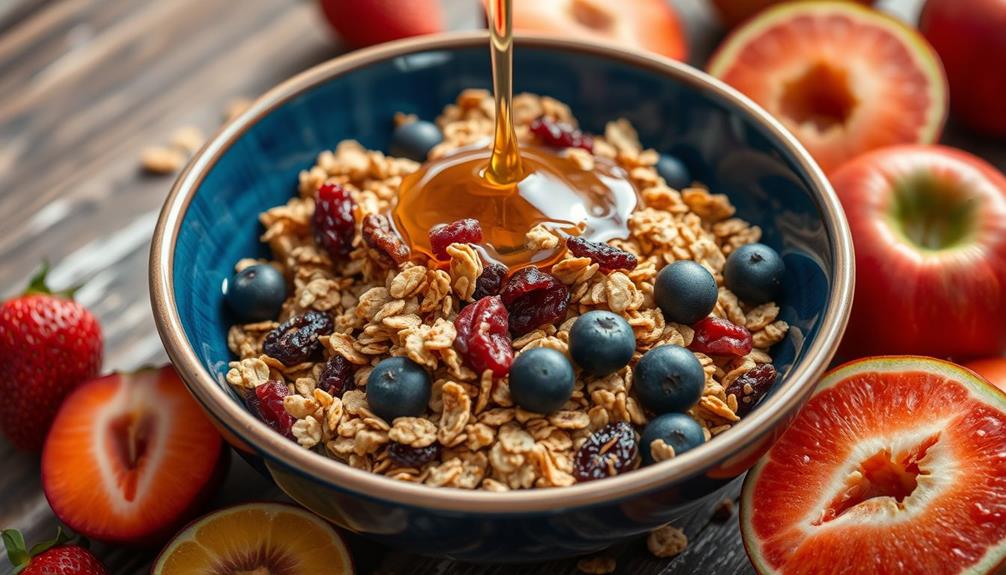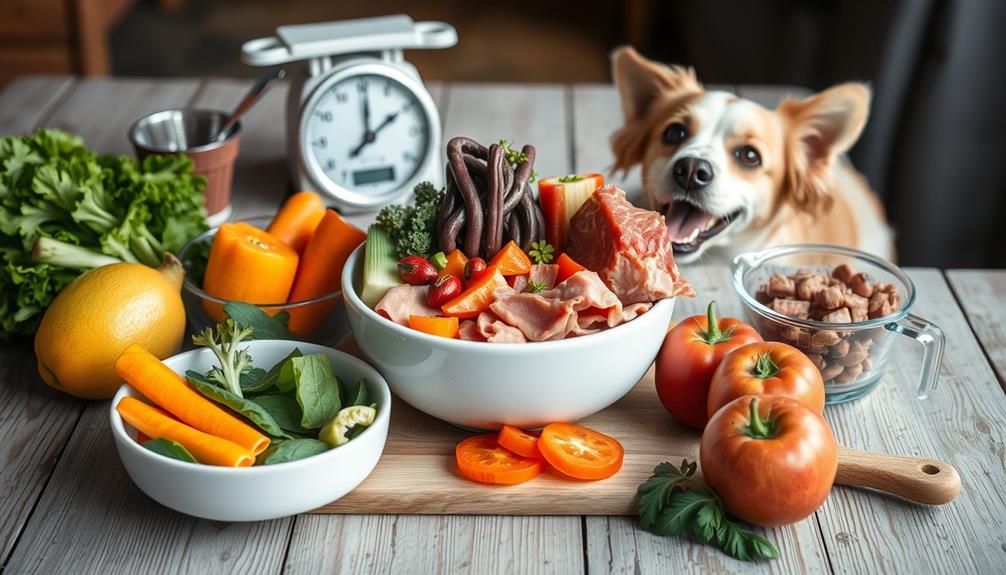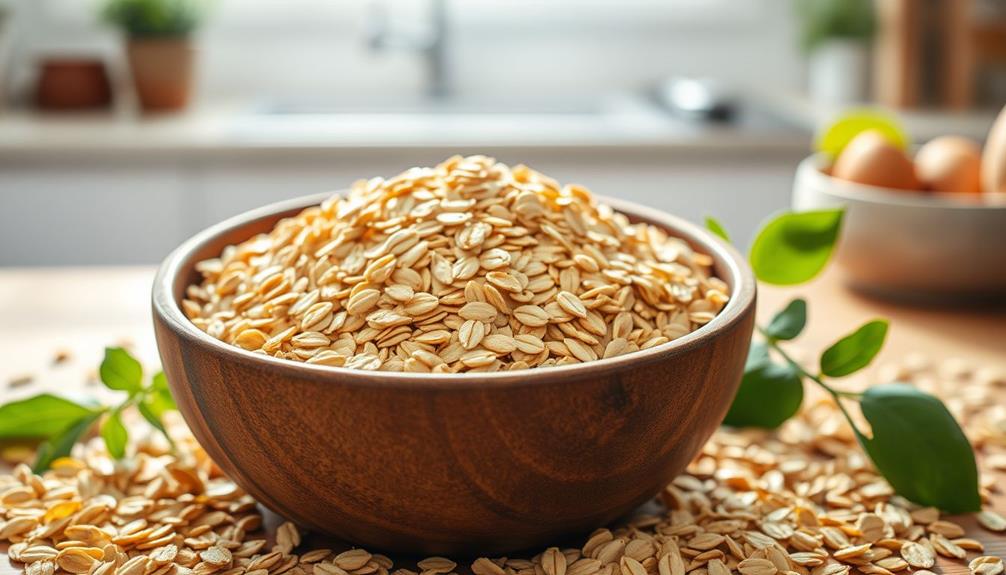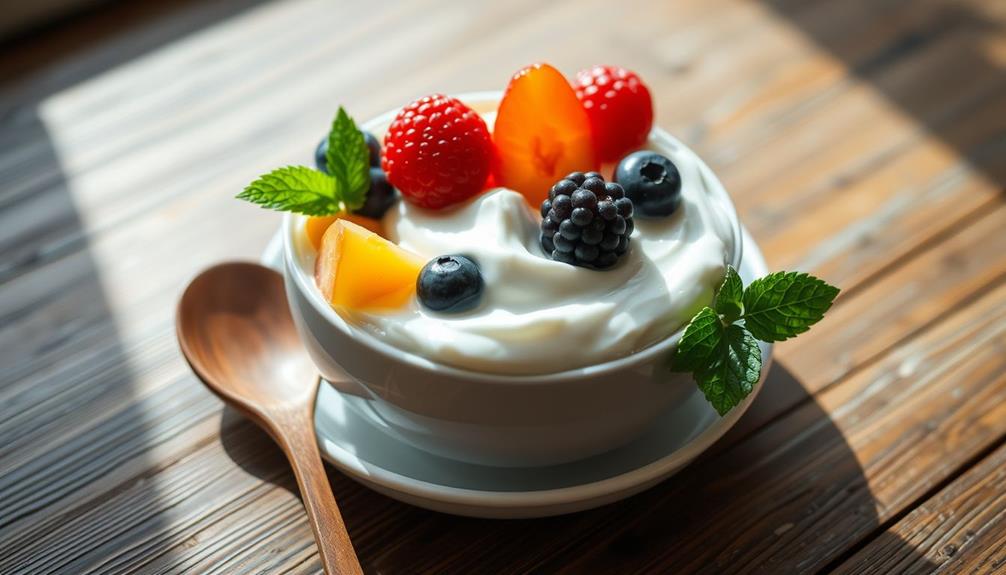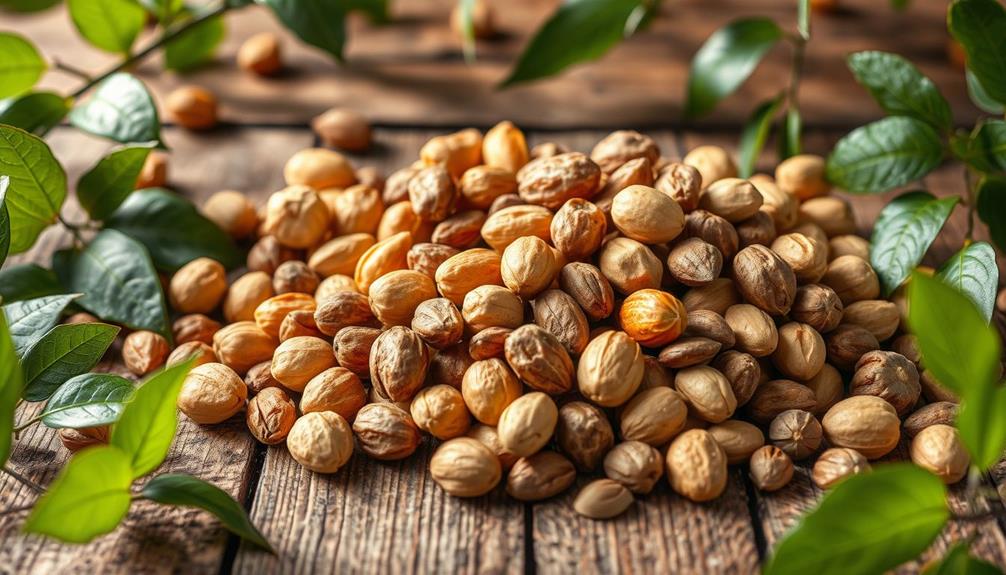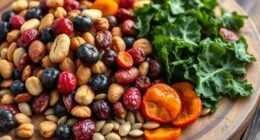Yes, granola can be considered raw food if it's made from whole, unprocessed ingredients and dehydrated at low temperatures. This method helps retain essential nutrients and flavor, so you get the benefits of antioxidants, healthy fats, and fiber. Common ingredients like oats, nuts, seeds, and dried fruits keep it nutritious and customizable to your taste. However, be cautious—some commercial granolas might not meet raw standards. Always check for "raw" certification. If you're curious about preparation tips and the best ways to enjoy granola, there's plenty more to explore.
Key Takeaways
- Raw granola is made from whole, unprocessed ingredients and is dehydrated at low temperatures to retain nutrients.
- It typically includes nuts, seeds, whole grains, and dried fruits, making it a nutrient-dense food option.
- Raw granola provides health benefits such as high fiber content, antioxidants, and healthy fats for a balanced diet.
- Customizable recipes allow for dietary restrictions, including gluten-free, nut-free, and vegan options.
- Proper preparation and food safety are essential to avoid harmful bacteria and ensure nutritional balance.
Understanding Raw Granola
When it comes to understanding raw granola, you'll find it's made from whole, unprocessed ingredients that keep their nutrients intact. Unlike traditional granola, raw granola isn't baked; it's typically dehydrated at low temperatures. This process preserves the raw status and nutritional benefits of the ingredients.
You'll often encounter a mix of whole grains, nuts and seeds, and dried fruit in your raw granola. Raw granola can be a great source of antioxidants, much like other nutrient-rich foods which may aid in digestive health. Common components include soaked and dehydrated buckwheat, ground flaxseed, and sunflower seeds, all contributing to a rich texture and flavor. The dried fruit adds natural sweetness, making it a delicious choice without added sugars. Plus, you get healthy fats from the nuts and seeds, which are essential for a balanced diet.
Preparing raw granola is simple and convenient. You can mix dry ingredients with wet ones without needing an oven, making it an easy option for quick snacks or toppings.
This versatility allows you to enjoy raw granola in various ways—on smoothie bowls, yogurt, or just on its own. By choosing raw granola, you embrace a nourishing option that aligns well with a raw foods lifestyle.
Ingredients for Vegan Raw Granola
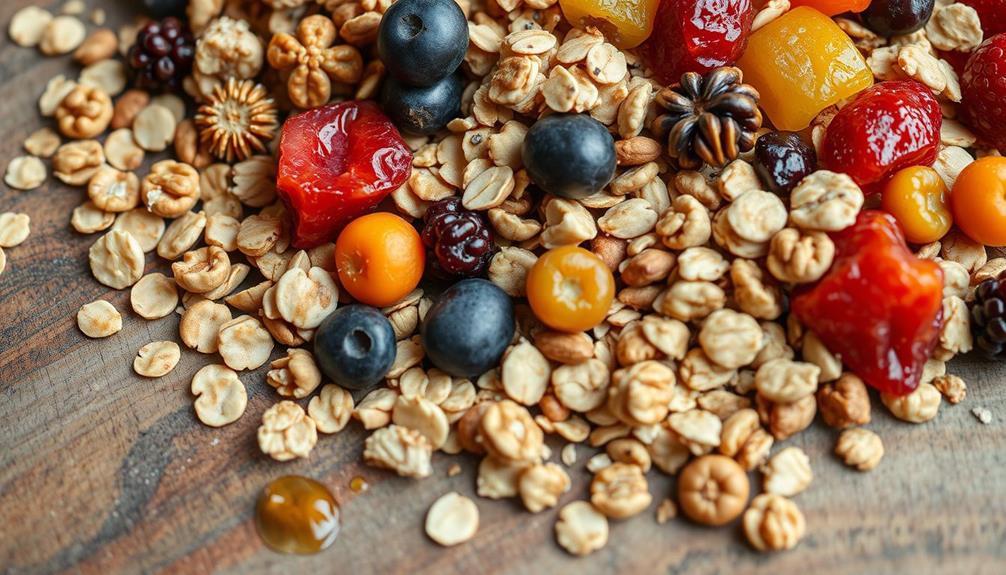
Vegan raw granola is packed with a variety of wholesome ingredients that not only enhance its flavor but also boost its nutritional value. In crafting your own raw granola, you'll want to start with raw almonds and walnuts, as they provide healthy fats and a satisfying nutty taste.
Hemp seeds are another fantastic addition; they're rich in plant-based protein and essential fats, making them a powerhouse ingredient for your vegan raw diet. Incorporating essential oils for hair growth into your diet can also support overall wellness and improve your hair health from the inside out.
Don't forget to include ground flaxseed, which offers omega-3 fatty acids and has anti-cancer properties, enhancing the granola's health benefits. For sweetness, Medjool dates are perfect—they serve as a natural sweetener that adds a delightful fruity flavor without relying on refined sugars.
Together, these ingredients create a nutrient-dense granola that aligns beautifully with raw food dietary principles. You can also consider adding other plant-based foods, like dried fruits or spices, to further customize your blend.
With the right mix, you'll enjoy a delicious and healthful snack that fits perfectly into your lifestyle.
Tips for Making Granola

Creating your own granola can be a fun and rewarding experience, especially with the wholesome ingredients you've gathered. To make delicious granola, start by pulsing nuts like almonds and walnuts in a food processor for 20-30 seconds. This helps maintain that crumbly texture you want. Quick preparation is key—you can whip up your granola in less than 5 minutes without any baking required!
Consider tracking your ingredient costs as part of a personal budget to verify you're making economical choices while enjoying your healthy snacks budgeting for healthy snacks.
For added nutrients, include ground flaxseed and hemp seeds. Pulse these with your nuts for another 30 seconds. To sweeten your granola naturally, blend Medjool dates in for 2-3 minutes until a sticky dough forms. This won't only enhance flavor but also contribute to the health benefits of your mix.
Once you've combined everything, store your granola in a tupperware container in the refrigerator. This keeps it fresh and prevents spoilage.
Preparation Techniques
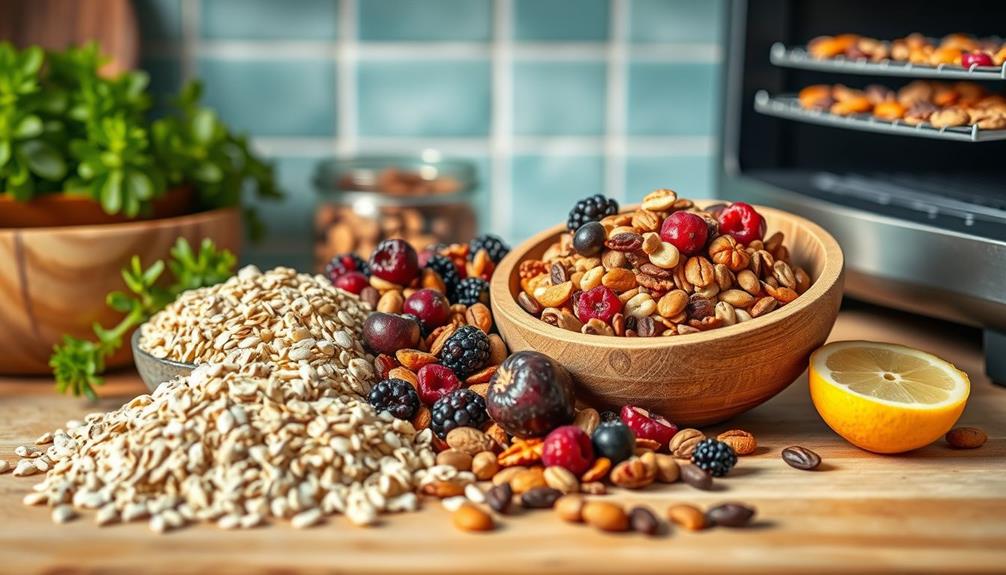
Preparing raw granola involves a few key techniques that elevate its flavor and texture while keeping it healthy. To start, soak your nuts and seeds overnight. This step enhances digestibility and releases their nutrients, which is similar to the benefits of hydration in a gout-friendly diet.
After soaking, it's time for food processing. Pulse the soaked nuts and seeds until they're crumbly but not powdered. This will help maintain a delightful crunch in your granola.
Next, combine your dry ingredients, like oats and spices, with a wet mixture of natural sweeteners and oils. Mixing these ingredients guarantees an even distribution of flavors throughout your granola.
Once your mixture is ready, spread it out evenly on dehydrator trays. Dehydrating is essential for raw granola; keep the temperature below 118°F to preserve enzymes and nutrients. Allow it to dehydrate for 10 to 12 hours at 115°F. This process creates a crunchy texture without compromising its raw food diet status.
Nutritional Benefits of Raw Granola

When you incorporate raw granola into your diet, you're not just enjoying a tasty snack; you're also reaping numerous nutritional benefits. Raw granola typically includes nutrient-dense ingredients like nuts, seeds, and dried fruits, which provide essential vitamins, minerals, and healthy fats that are beneficial for your overall health. For example, adding chia seeds can enhance your granola's omega-3 fatty acid content, promoting heart health and supporting digestion high in omega-3 fatty acids.
One of the standout features of raw granola is its high fiber content, thanks to whole foods like nuts and seeds. This fiber promotes digestive health and helps you feel full longer, making it easier to manage your appetite.
Additionally, raw granola is rich in antioxidants, particularly from nuts and seeds, which can help combat oxidative stress and reduce the risk of chronic diseases.
The combination of healthy fats in raw granola supports heart health by improving cholesterol levels and providing essential fatty acids. By choosing raw granola that contains natural sweeteners like dates, you can enjoy a healthier alternative to refined sugars, helping to stabilize your blood sugar levels.
Risks and Considerations
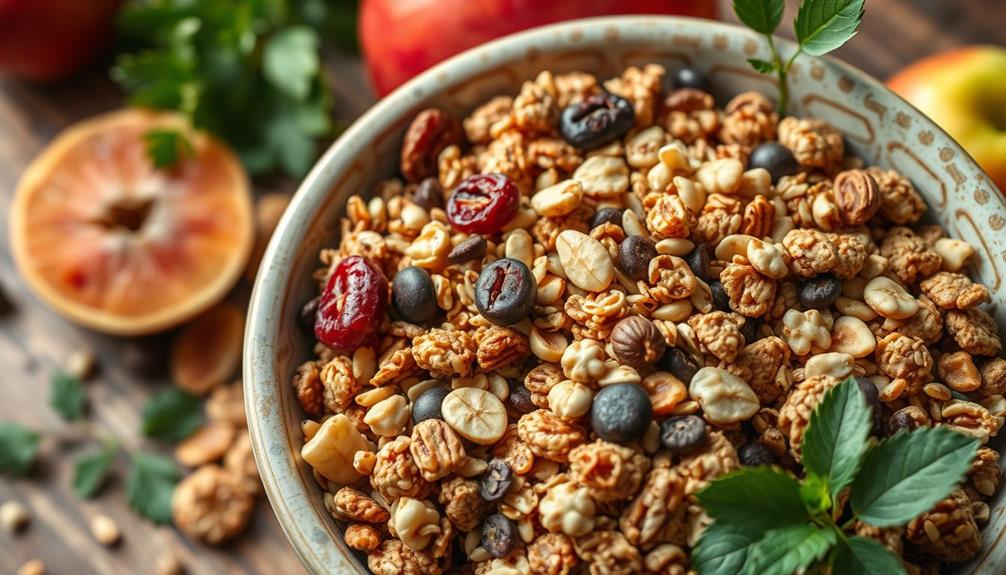
While raw granola can be a nutritious addition to your diet, it's important to be aware of potential risks and considerations. Many commercially available granolas are baked, which means they don't meet the raw food temperature limit of 104°F to 118°F. If you choose to make or buy raw granola, you need to guarantee proper preparation to avoid food safety risks.
Additionally, understanding the various brewing methods can enhance your overall approach to nutrition and meal planning.
Certain raw ingredients like nuts and seeds can harbor harmful bacteria when consumed raw, posing health issues if not handled correctly. It's vital to select your ingredients carefully, as some raw foods contain toxic substances. For instance, raw kidney beans and cassava can lead to serious health problems if they're not properly prepared.
Additionally, relying solely on raw granola can create nutritional imbalances. If you don't complement it with other food sources, you may end up deficient in essential nutrients like protein and B vitamins.
To enjoy raw granola safely, always prioritize food safety, select fresh ingredients, and balance your diet to maintain peak health.
Community Feedback

You've likely noticed how many people are excited about their granola creations, sharing unique adaptations that fit their tastes and diets.
From gluten-free options to creative flavor combinations, user experiences show just how versatile granola can be.
It's interesting to see how different dietary restrictions, like those for pet care, can inspire unique ingredient choices in human foods as well.
For instance, many are exploring healthier snack options, similar to safe snacks for hamsters, which can encourage creativity in granola flavors.
What variations have you tried, and what challenges have you faced in sourcing ingredients?
User Experiences
Community feedback reveals that many people find raw granola both easy to make and delicious, often praising its delightful texture and flavor. Users appreciate that the preparation process is straightforward, making it a convenient option for those looking to enhance their diet with healthy foods.
Many have enjoyed incorporating various seeds, nuts, and spices, which not only adds to the taste but also contributes to the granola's versatility. Additionally, some users have emphasized the importance of using high-quality protein sources to further boost the nutritional value of their granola.
Parents find it particularly appealing as a kid-friendly food option, as it's both nutritious and satisfying. Feedback highlights how raw granola can serve as a great breakfast or snack, providing energy-boosting qualities that help manage weight throughout the day.
However, some users do mention challenges in sourcing raw ingredients like buckwheat, which can limit accessibility for certain individuals.
Recipe Adaptations
Many users are excited to share their creative takes on granola recipes, highlighting the versatility that makes it a favorite in their kitchens. Recipe adaptations abound, with many substituting nuts or adding spices like cinnamon and cardamom to enhance flavor.
You can easily adjust your granola made at home, incorporating dried fruits or seeds to suit your taste and nutritional needs. For those avoiding traditional grains, grain-free options have become popular, too. Additionally, much like the unique planter designs that cater to individual styles, granola can be personalized to reflect one's culinary preferences.
Some users have faced challenges in sourcing raw ingredients like buckwheat. They've engaged in discussions about practical alternatives, ensuring everyone can enjoy their granola creations. Importantly, many participants note how these adaptations can help with weight loss by minimizing added sugars and increasing the presence of plant protein.
You might find it beneficial to experiment with different nuts and seeds, creating a personalized blend that caters to dietary restrictions, particularly for kids. The community encourages this kind of experimentation, emphasizing that granola can be tailored to fit any lifestyle or preference, making it a truly adaptable and delicious choice for your kitchen.
Recipe Variations
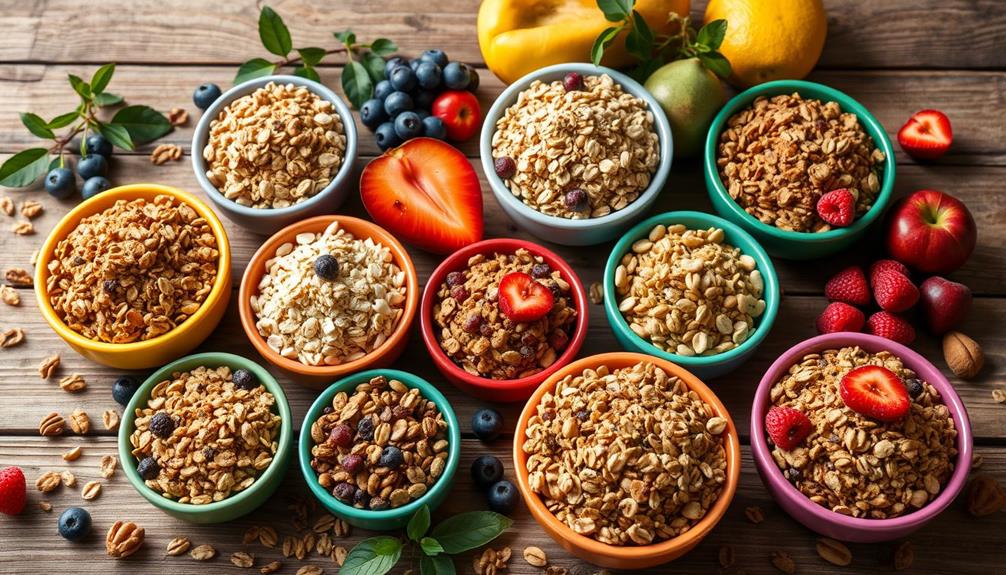
When it comes to granola, you can easily customize your ingredients to match your taste and dietary needs.
Consider incorporating unique breakfast recipes like cornbread pancakes or fresh fruit to elevate your granola experience.
Think about enhancing flavors with spices or swapping out traditional bases for gluten-free options like buckwheat.
With a few simple adjustments, you can create a granola that's uniquely yours, whether you're aiming for low-sugar or nut-free versions.
Customizable Ingredient Options
Granola offers endless possibilities for customization, allowing you to tailor each batch to your unique taste and dietary preferences. You can start by choosing alternative sweeteners like agave syrup or maple syrup, catering to your specific needs.
Next, consider adding a variety of nuts and seeds—pecans, chia seeds, or almonds—to boost the nutritional content and enhance flavor. Incorporating dried fruits such as cranberries or apricots not only adds natural sweetness but also introduces diverse textures and flavors.
If you're looking for a grain-free option, try substituting traditional oats with buckwheat or quinoa, which will still give you that chewy texture you love.
Don't forget about spices! Adding cinnamon, nutmeg, or cardamom can elevate your granola's flavor profile while providing additional health benefits.
With these customizable ingredient options, you can create a granola that fits your lifestyle and satisfies your taste buds. The beauty of granola is in its versatility, so feel free to experiment and find the perfect blend that resonates with you.
Enjoy the journey of making your granola truly your own!
Flavor Enhancement Techniques
To elevate your granola's flavor, consider experimenting with various techniques that enhance both taste and texture. You can easily transform your granola with the right combination of spices, dried fruits, nuts and seeds, and sweeteners.
| Flavor Component | Suggestions |
|---|---|
| Spices | Cinnamon, Nutmeg, Cardamom |
| Dried Fruits | Cranberries, Apricots |
| Nuts & Seeds | Pecans, Chia Seeds |
| Sweeteners | Maple Syrup, Agave |
Adding spices like cinnamon or nutmeg can create an aromatic flavor enhancement that makes your granola irresistible. Incorporating dried fruits not only adds natural sweetness but also a chewy texture that contrasts nicely with crunchy elements. Experimenting with nuts and seeds diversifies the taste and boosts nutritional value.
For that extra sweetness, adjust the amount of sweeteners like maple syrup or agave to match your preference. Finally, if you're after a crunchy texture, consider adding coconut flakes or cacao nibs, which contribute their unique flavors. With these techniques, you'll create a delicious granola that caters to your taste buds!
Dietary Restrictions Considerations
Many people are looking for ways to enjoy granola while accommodating various dietary restrictions.
Luckily, you can easily customize your granola recipes to fit your needs. Here are some variations to take into account:
- Gluten-Free: Substitute traditional oats with buckwheat or nuts for a grain-free option that maintains texture.
- Nut-Free: Replace nuts with seeds, like pumpkin or sunflower seeds, making your granola safe for those with nut allergies.
- Vegan: Easily keep your granola plant-based by using maple syrup or agave as a sweetener and avoiding any animal-derived ingredients.
- Raw: Stick to uncooked ingredients, ensuring you don't bake or heat your granola above 118°F, preserving its raw status.
- Flavor Customization: Enhance your granola with spices like cinnamon or vanilla, allowing you to adjust flavors without adding sugars.
Storage and Equipment
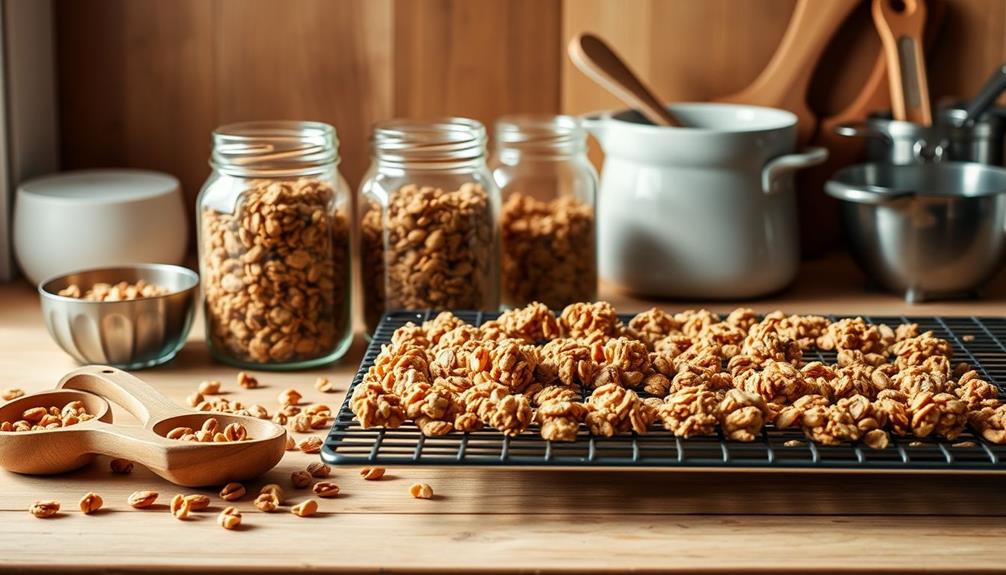
When preparing raw granola, having the right equipment and storage methods can make all the difference in maintaining its quality. A dehydrator is vital for ideal results, allowing you to dry ingredients without exceeding the critical temperature limit of 118°F (48°C).
If you don't have a dehydrator, you can use an oven on a low setting, but be cautious not to cook the granola, as that would compromise its raw status.
Keep an eye on the drying time—typically around 10-12 hours—so you achieve the perfect texture without over-dehydrating, which can alter the taste.
After preparing your granola, proper storage is essential to maintain its freshness and crunchiness. Use airtight containers, like mason jars, to keep moisture out and flavors intact. If you want to extend its shelf life further, consider refrigeration.
Lastly, when selecting a dehydrator, research various models, as options like the budget-friendly Nesco Professional can vary in quality and performance.
Investing in the right equipment not only preserves your granola's quality but enhances your overall raw food experience.
Frequently Asked Questions
Is It OK to Eat Granola Raw?
Yes, it's totally okay to eat granola raw! Just make sure it's made with uncooked ingredients. Enjoy the crunch and nutritional benefits without worrying about added sugars or preservatives from baked versions.
Is Granola Considered Clean Eating?
Did you know that some granolas can contain up to 30 grams of sugar per serving? If you choose granola with whole, minimally processed ingredients, it can absolutely fit into your clean eating lifestyle.
Is It Healthy to Just Eat Granola?
Eating just granola isn't the healthiest choice. While it offers nutrients, it can be calorie-dense and high in sugars. Balance it with other foods to guarantee a well-rounded, nutrient-rich diet. Moderation's key!
Can You Eat Granola Without Cooking?
Yes, you can eat granola without cooking. Just combine raw oats, nuts, seeds, and sweeteners. It's a quick, nutritious snack that retains essential nutrients, making it perfect for a healthy diet. Enjoy it anytime!
Conclusion
In exploring whether granola can be classified as raw food, you realize it's not just about the ingredients. It's about the love and care you put into its preparation. By choosing raw components and avoiding heat, you reveal a world of flavors and nutrients. However, remember to balance your enthusiasm with caution—raw doesn't always mean healthier for everyone. Ultimately, the journey of making granola reflects your personal health choices and creativity in the kitchen.

